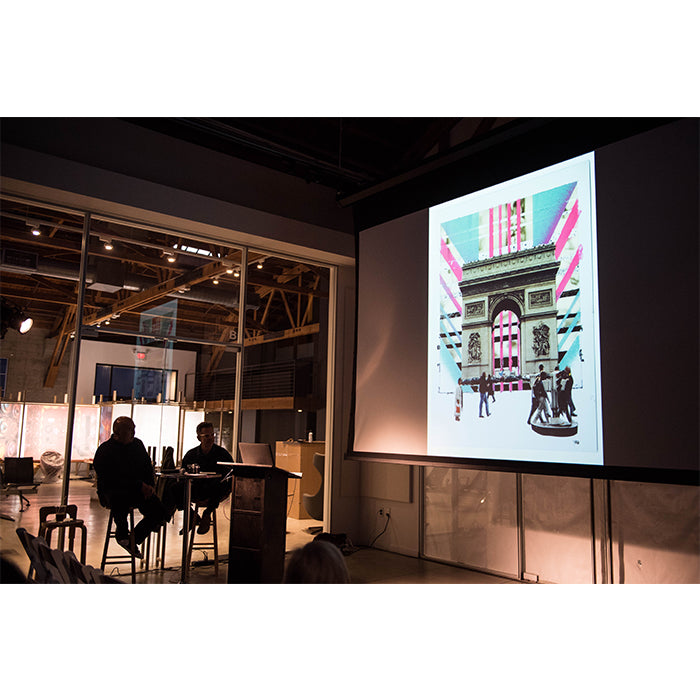[blog-marquee]
Oblow shares how skateboarding—from the ‘80s to present day—has defined him as an artist.
[/blog-marquee]
Helms Design Center, Los Angeles. Located in the historic Helms Bakery building, the Helms Design Center is anything but subtle. This mecca of modern design is just that—a destination for creators of all mediums. It’s only fitting that the inaugural CaseStudies event occupied a space as significant as the occasion. Tall, double glass panels make a grand entry, giving way to a long, light and airy space with tall white walls that lead to wide, beaming skylights scattered around a buttress ceiling with exposed wood. Bold spherical lamps of various sizes hang staggered, filling the room with warm light while videos play on opposing sides of the room, proudly displaying photographer/artist Mark Oblow and our partnership with AIGA LA.
At 6:45pm, the doors opened and the room filled with Oblow’s friends and followers, Incase fans, AIGA LA members and, of course, the next generation of creative professionals. Everyone mingled, then sat down; the lights dimmed soon after. Incase marketing manager Billy Garner took the mic to officially kick off our first CaseStudies event and introduce the inspiring artist the audience had been waiting for: Mark Oblow.
[standout-image]

[/standout-image]
As the perfect opening, Oblow played a slideshow of his photography over the years—from skateboarding shots, candids and models to capturing some of the most famous celebrities. A quick two-minute glimpse into his incredible journey that got him to where he is today in his career—and now, in the seat at the front of this room in LA full of people inspired by his work.
Serving as the moderator, Oblow’s longtime friend and managing partner Yong-Ki Chang began the conversation with Oblow, who then took the spotlight and brought the audience into his world—how skateboarding has always influenced his creativity and how it opened up a wealth of opportunity he may have never otherwise received.
[carousel]













[/carousel]
Oblow explained that growing up in Oahu, Hawaii in the ‘80s immersed him in the surf and skate culture from the start—and he quickly found that skateboarding was a way of expressing himself through the actions of surfing, like how to ride a wave, how to get barreled; stuff he could do in his own neighborhood on a skateboard. And Hawaii was the perfect place because it’s a skater’s paradise 24/7; there are ditches, hills and lots of pools that could be emptied. The ‘80s skateboard scene was welcoming and all-inclusive—with such a small community of skateboarders, everyone easily connected with each other through this mutual love.
During that time, Oblow’s close friends were some of the best skateboarders on the planet (he was even sponsored himself) and his inspiration for everything. And once he got his first camera (a gift from his mom), it all came together: He knew he needed to capture this whole world around him.
As Oblow spoke about his start in photography, Chang brought up Thrasher Magazine: Oblow sold two photos to the publication that were featured in a couple issues—all when Oblow was a young teen who had never taken a photography class.
[standout-image image2]

[/standout-image image2]
Eventually, at school during his senior year, he was able to get into a photo lab to print his own photos, and his purpose became even clearer. “I couldn’t get out of there…I was in heaven,” Oblow said. “It was a whole new world to me. That’s when I started to realize…[art, photography] is something that is for me; this is something that I can lose myself in. I could do a stipple drawing for hours and think of nothing else and not stress and not have any other worries. That was the beginning of the freedom of the mind.”
With the audience completely intrigued, Oblow went on to explain the connection between skateboarding and art. In the ‘80s, brands dedicated to making skate shoes or apparel didn’t exist, so skaters just started making their own stuff and creating their own brands. They did things their own way and made it all theirs without worrying or caring what everyone else thought or letting anyone tell them “no”.
“I’ve never seen another sport where guys and girls can flow into all these different artistic paths and places,” Oblow said. “Photographer, designer or graphic artist. There are so many different avenues that can come from this. It’s always been an outlet.”
[video-player video1 sound]
https://www.youtube.com/watch?v=RPHGMjGXY2k&t=337s
[/video-player video1 sound]
As the discussion continued, Oblow took the audience through more of his photos—telling a compelling story behind each shot and digging deeper into all the various people, places and things that have inspired him over the years.
Throughout the evening, Oblow was able to describe his career trajectory from being recruited by Quiksilver to shoot for the brand and having his photos printed in major publications to becoming the creative director for several surf and skate brands, then going on to travel the world to photograph big celebrities (like David Beckham). Ultimately, he got to the point where it was too much and decided to refocus his efforts and get back to what inspired him from the beginning: skateboarding. Since then, he’s been taking photos for brands and subjects he’s passionate about, creating art in new ways (poetry, painting, etc.) and starting his own skate brand, called Together Together, with a friend.
At the end of the night during the Q&A, Oblow was asked what has helped him get to where he is today. He said, “Hawaii made me very humble. Where you just put your head down and go. If you really believe in [your art] and you really have pride and ownership and you feel like you’ve worked hard, you can feel proud about having done all that.”
[standout-image image3]

[/standout-image image3]

